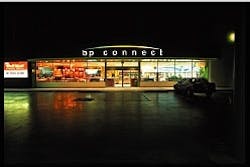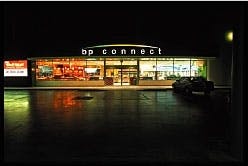Fill 'er up?
Over the past decade, retail gasoline stations have continued to modernize their facilities in order to give customers what they desire most, convenience, which is the operative word that continues to drive the evolution of service stations and how consumers buy gasoline.
The days of full-service stations where you pull in and have your tank filled, windshield cleaned, and oil and tires checked by an attendant are quickly vanishing from most retail sites. Today, the majority of service stations are now equipped with an easy 1-2-3 payment process when "paying at the pump" by credit or debit card. To make paying at the pump even more expedient, ExxonMobil Corp. has created the "speedpass," which is a small portable transponder wand that attaches to your key chain and is preprogrammed with your credit or debit card information. Customers wave the wand before a scanner, and it automatically communicates their credit card information. ExxonMobil calls it the most convenient and safest way to pay.
Company credibility
As we progress further into the new millennium, oil companies continue to wrestle with the issue of credibility when it comes to the gasoline-buying consumer.
Unfortunately, the only contact that the average consumer has on a day-to-day basis with most oil companies is at the service station.
During this summer's driving season, the average US price of regular self-serve gasoline peaked at a $1.50/gal, causing many gasoline-buying consumers' tempers to flare, which resulted in oil companies once again shouldering the blame for high gasoline prices. In hopes of restoring consumer confidence, companies such as BP have made strides to make the whole gasoline-buying experience more pleasurable.
Beyond petroleum
This year, BP plans to take the typical gasoline pump and convenience store to a whole new level. Late this year, BP was to unveil its new convenience retail site-BP Connect-in London, Cleveland, and Indianapolis. The new site is based on a prototype service station built at a secret warehouse in Atlanta (see photo). The site-partially powered by solar energy-will feature in-store internet kiosks where customers can check weather, traffic conditions, pay with cash or credit cards, and call up directions to local destinations, all while stopping to fill their tanks. Also, customers will be able to use an on-screen menu at the pump to select a made-to-order sandwich and have it waiting for them inside the store upon filling their tanks.
Doug Ford, BP chief executive officer for refining and marketing, said, "At the heart of BP Connect is the concept of 'innovative mobility'-providing customers with time-saving, cost-effective, and integrated services for today's digital economy."
In addition to online service, BP is making plans to build what it claims is the world's first energy-neutral retail site, at Alcala de Henares in Madrid-also known as La Garena. If the new site is approved by the Spanish authorities, the station will feature a canopy that will use thin-film solar panels, a fuel cell that processes natural gas at a high energy efficiency of 85% to supply heat and electricity, and a wind-powered generator that will help meet the site's energy needs.
BP's innovative ideas may be the kind of answer oil companies are looking for to bridge the gap between them and the gasoline-buying consumer.

